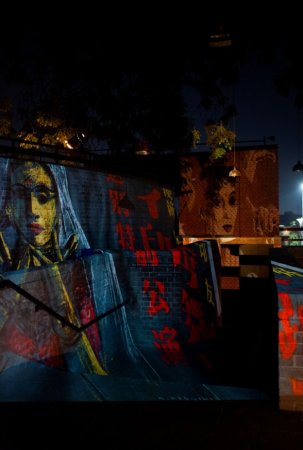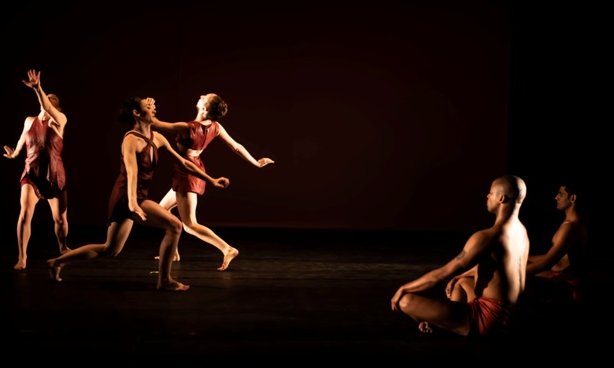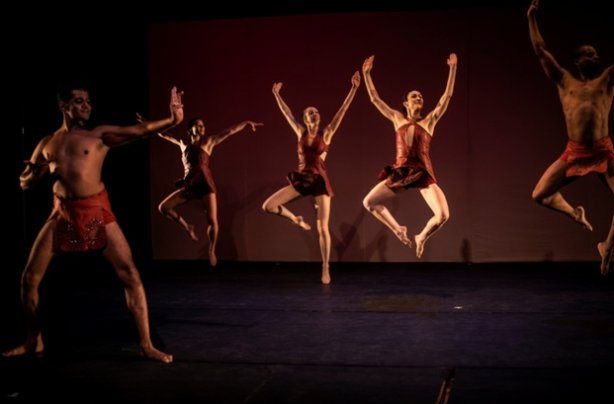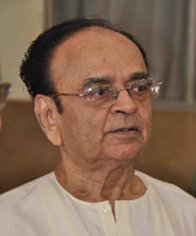
|   |

|   |
'Shakti: A return to the Source' is unparalleled in its conception and presentation - Dr. S.D. Desai e-mail: sureshmrudula@gmail.com January 11, 2020 Jonathan Hollander's artistic performance piece Shakti: A Return to the Source his Battery Dance Company (New York) presented on Dec 29 as part of Vikram Sarabhai Inter Art Festival in the 40th year of both the Company and Natarani at Darpana Academy holds significance to the young generation of artists and art lovers of Ahmedabad and elsewhere for a number of reasons. The foremost is a combination of his brain and heart, the Gangotri of unifying creative ideas in art.  Installation at Natarani Clad in simple attire, looking Indian in the right sense, in a level voice with emotion Hollander admits to missing Mrinalini Sarabhai, "a wonderful human being and a great artist," calls Mallika on stage and presents to her two certificates, one for Natarani and the other for Darpana. He recalls how a few years ago Raag Durga rendered by Pt Rajan Mishra and Sajan Mishra so resonated within him that he was inspired to create Shakti: A Return to the Source and how in Delhi last year 'in a magical moment' he saw the vocalist brothers walking up to the Kamani gate and occupying front seats at its performance. The performance, without an earlier parallel in its conception and presentation, prefaced by its artistic director-choreographer with a low profile, turns out to be significant with its interpretation of the female power as primal and substantial. The Mishra brothers' relaxed enunciation of the power-charged late evening raag anchored by bhakti and shringar, gradually blooming to the full in sombre veneration is a treat to the ear and the soul. Accompanied by delectable beats on the pakhawaj and the tabla, the six dancers merge with the notes in their silent modern dance movement visually interpreting the vocal rendition.  The dancers emerge soundlessly as the naad rises from within with Jay jay jay Durga maa... The presiding female deity is represented by three graceful trained female dancers. Sitting modestly on their left in dhyaana are three virile male dancers. As the divine dance goes on uninterrupted, singly and by the three, each of the three men rises, pays obeisance to the Shakti, taking a stylized parikrama, and goes back to his seat in all modesty. They rise as well later from time to time, changing the choreographic pattern and joining the female dancers. The voice rises with power with words like duhkhaharini, paapanivaarini and steadies like a flame. The intricate angabhangi and interactive body vinyaasa with the female dancers get elaborate and suggestive. The vocal pattern on the higher octave gets a bit dramatic with a restrained abandon and the supple movements in the engaging choreography demonstrate vanquishing and riding a tiger, now fighting a battle, now a triumphant overpowering of the evil force. No display of explicit fierceness, violence or unfolding of a sensational narrative. The charm of the ballet is in its metaphoric suggestion.  Shakti: A Return to the Source celebrates India's pioneering conception of a female power holding the universe and a quest by artists for a luxuriant unified culture today. The performers were Robin Cantrell, Sean Scantlebury, Sarah, Vivake, Bethany Mitchelle and Unnath, all dedicated and accomplished. Earlier, the India premiere of The Red Line took place and Unnath Hassan Rathnarazu (Bengaluru) gave a taste of a very pleasing Mallari performance.  Dr. S.D. Desai, a professor of English, has been a Performing Arts Critic for many years. Among the dance journals he has contributed to are Narthaki, Sruti, Nartanam and Attendance. His books have been published by Gujarat Sahitya Academy, Oxford University Press and Rupa. After 30 years with a national English daily, he is now a freelance art writer. |